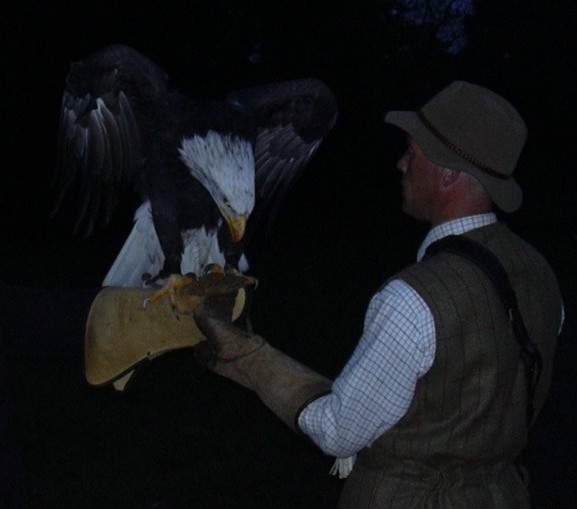Braco Scotland November 2002
Scotland - Braco - One of Kim's Christmas presents was a day out at the falconry. We jumped on the chuggypuff to Braco, and were picked up on the other end by a Land Rover 4x4. We weren't really sure where we were going as the Land Rover was quite mudy, so we weren't quite sure what we had gotten ourselves into. We were then dropped off at the Braco Hotel where the rest of the delegates had already started to gather. For the first half day, we were actually going to be handling the hawks and hunting rabbits. We jumped into a smaller land rover and headed off into the hills.
I'll warn you now - there are some pics of the Harris hawks having lunch... And it's not a cheese burger. So if you're squeemish, then be warned (I'll give you another warning - so read the descriptions before you look at the pics).
After our long journey, we were given a Harris Hawk for our very own. Actually there were only 4 hawks between the 6 of us, but don't let that detract from the story. Here is Kim learning just how friendly these little hawks can be.
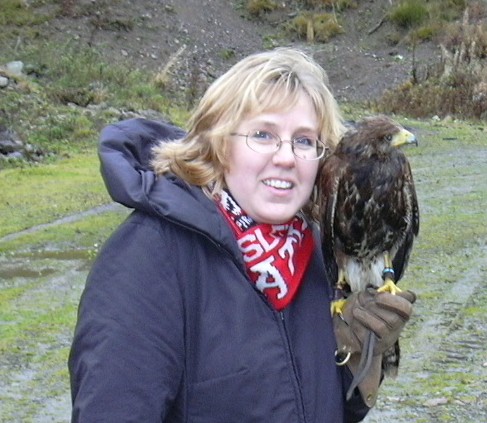
Awe, look at her - hamming it up for the camera. What a pretty bird.
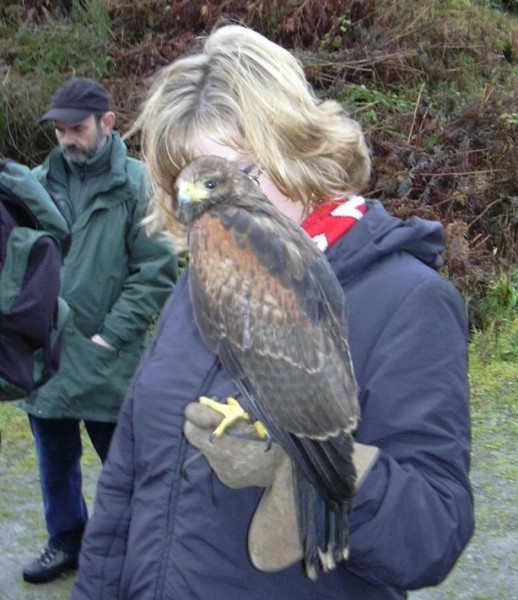
Kim is giving her bird a little pep talk - what to catch, where to fly. You know, the basics.
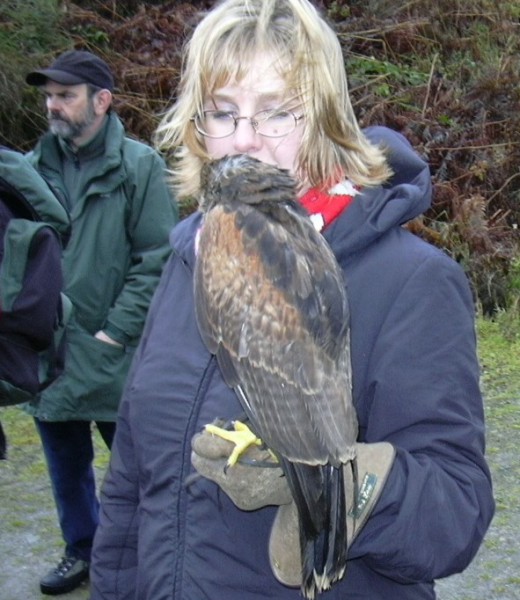
We have done our couple minutes of training, and we have a wild, rabbit hunter at the power of our disposal. Rabbits, be warned.
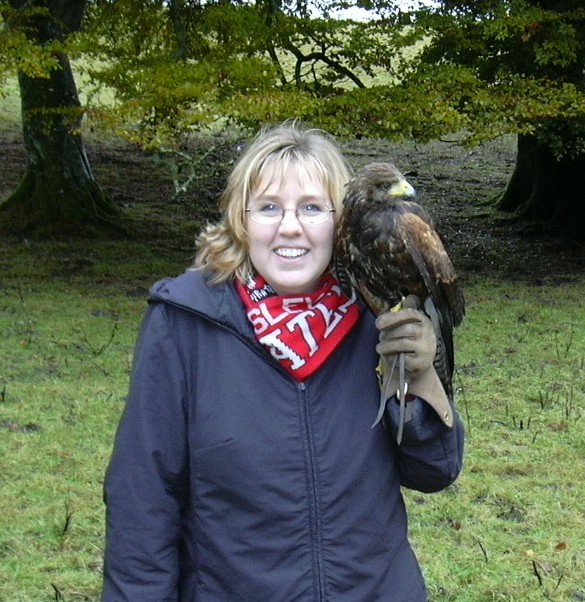
We spend the morning with these trained hunters. It was really interesting. The guide would take an albino ferret, and put him down the rabbit hole. The reason they use albino ferrets, is that way they are less likely to be confused with a tasty rabbit. A couple of minutes after being in the hole, the ferret would come out, and then we would walk over to the next hole. We did this for about 30 minutes with no response. Then, on one hole, we heard this rumble, and out shot a rabbit with four Harris Hawk's in hot persuit. From the speed of the rabbit, he wasn't too keen on being caught. We did this for another hour or so, and found several other rabbits that were up for a game of chase. We're happy to say, that with all the bird's efforts, they were unsuccessful in their game of tag.
It looks like the cute little hawk from the previous pics has turned into a wild, untamed hunter.
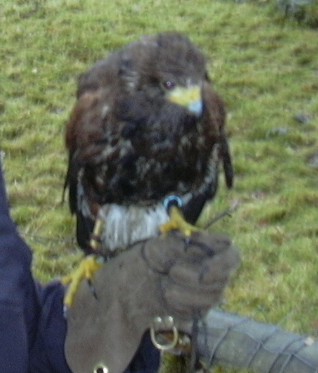
In the afternoon, we had several more demonstrations and were able to handle larger birds. But, first, we had to learn how to tie a falconer's slipknot with your right hand, while you had a bird on your left. Here, Kim is releasing the Harris Hawk that I just tied up. We had to practice the knot about 30 times before they would let us tie the bird to our arm.
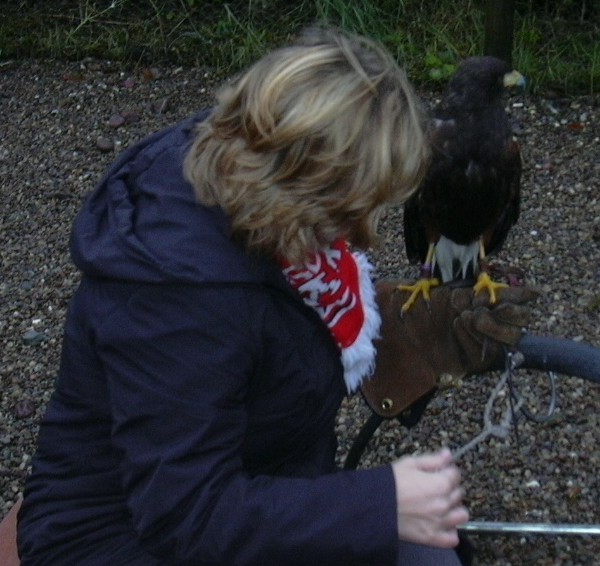
This is a close up of a successful slipknot. See how happy the bird looks? He knows feeding time is coming soon.
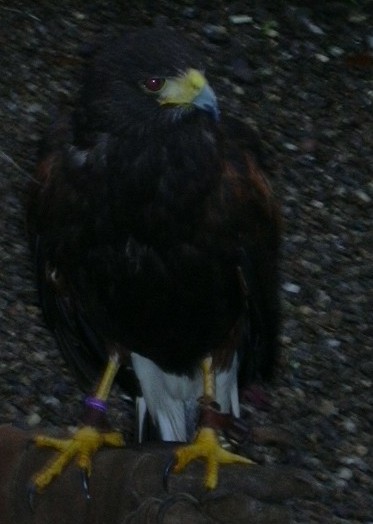
The bird did several acrobatic displays in the afternoon. Here, we had the bird start from high atop a tree, and the handler would have a victom hold his arms out and make a hoop. From here, the handler would put his glove (and of course some food) behind the person, and the bird would fly thru his arms and onto the glove.
Be warned, that the next couple of shots after this include the birds having lunch.

There's several things to mention here. First, when a bird kills or gets something good, it will spread it's wings around it, as if to say 'get off, it's mine'. This is called 'mantelling'. This is where we get the word mantel, like a place over your fireplace to show off items. Second, when a bird eats his fill, rather than the food going directly into it's stomach, it goes into a sac in it's throat and his throat pooches out. This is where the expression 'being fed up' comes from. And lastly, the treat that he is enjoying is a day old chick which they get from a local farm.
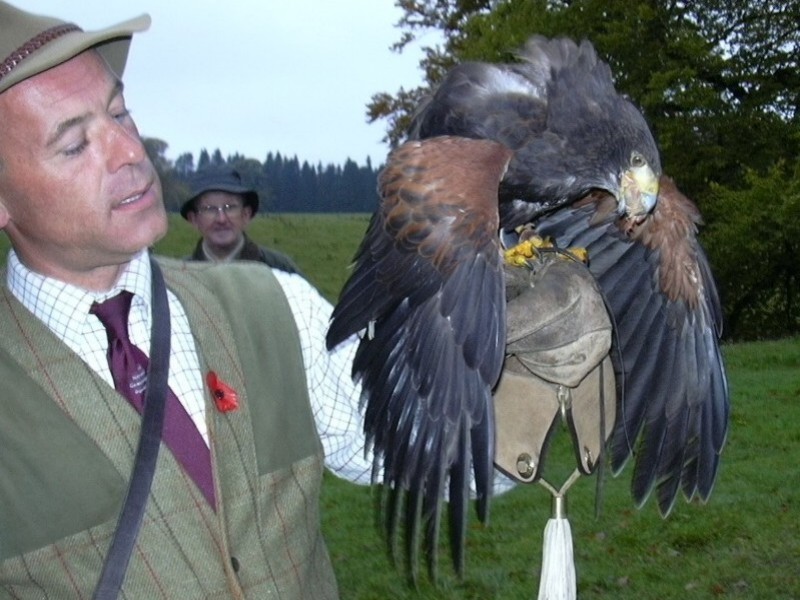
Here is a closer picture of him mantelling.
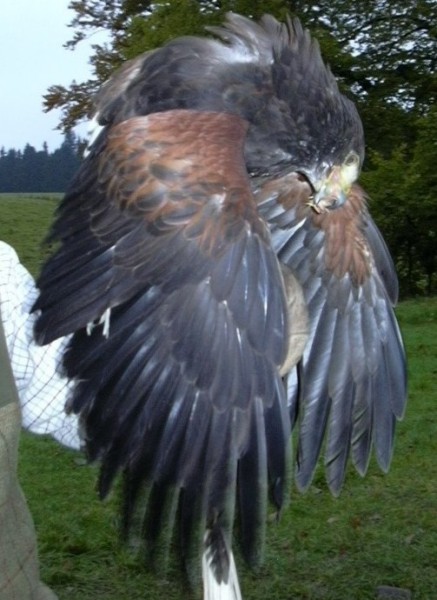
After we handled the Harris Hawk's, we were taken back to the bird sanctuary where they had dozens of birds on display. They have over a hundered birds, some on display, some in retirement, some in breeding programs etc. On the left is a bald eagle and on the right is a Russian eagle. The birds have two different types of perches. They are sitting on a stump perch, because they normally sit on the top of a tree where it is a flatter surface. The Harris Hawks normally sit on a branch so they will be sitting on a piece of metal in a bow shape. Infront of the brids is a little pool. This is not for drinking, but for washing their beaks and feet. These birds don't actually drink water, but get all the liquid they require from their food.

On the top center is a golden eagle, top right is a bald eagle, the two on the middle left are paragrin falcons, in the middle is a kestral hawk, and on the bottom right is another falcon. The one thing that you might notice is that they have about 10 feet inbetween each other. This is not to allow them to have their own personal space, but if they had more freedom, they would actually eat each other. They look friendly now, but they only think about food.
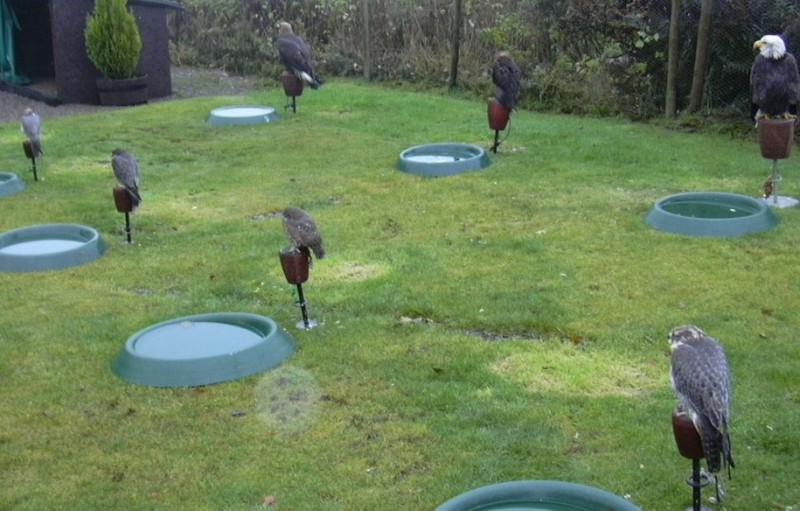
Here is the bald eagle with an owl.

Here is the bald eagle with an owl and kestral. The eagle is a little upset because someone stole his mousie toy. The other point to notice, is they have a very short leash. Another reason for this, is because if they were to try and fly away, with a short leash, they can't build much speed before they hit the end. Some birds could be doing 30mph at the end of a 20 foot leash, which would cause them serious injury (but it is really funny when a dog does it!)

This is a falcon from India. I can't remember it's exact name, but it's quite a bit like a paragrin.

This is a Kestral Hawk. It is native to the UK and quite a beautiful bird.
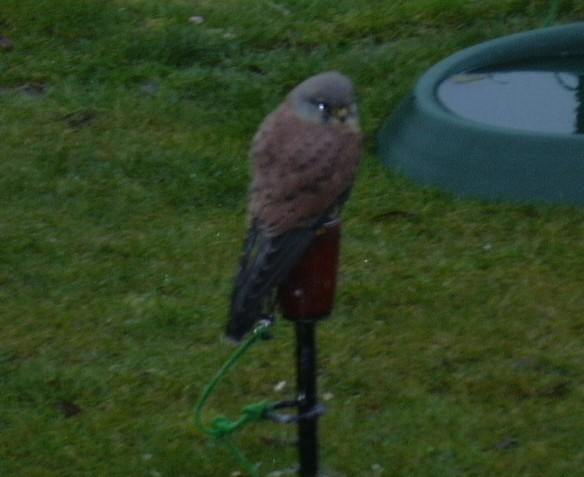
The owl looks like it found lunch...I'll just go for a little walk and have some chicken... That's obviously the kestral hawk on the bottom.

This is another Russian eagle. He was quite massive. Where the bald eagle had water in his dish, the Russian eagle has vodka. It's the only thing he will wash in.
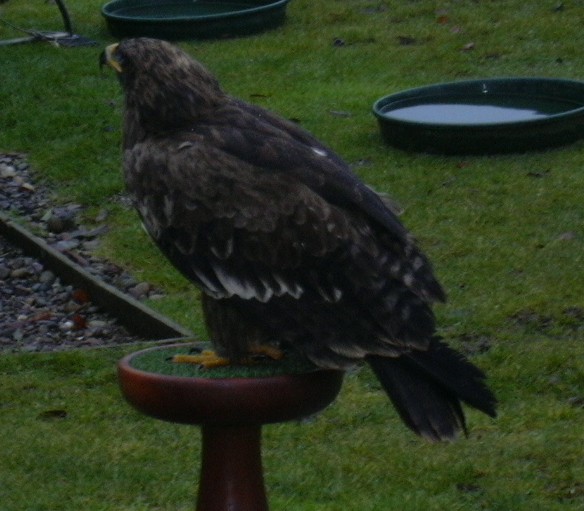
Look deep into my eyes... you are getting sleepy... you are getting sleepy... sleepy... you are now a trout... swim over here...
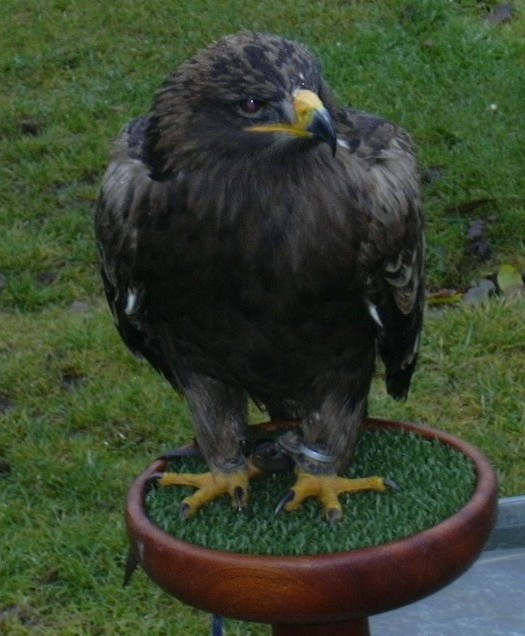
Here you can see the different types of perches - the Russian eagle has a post perch, while the Harris Hawk's have a bow perch. The other reason that these made this way, is that the hunters would put down their bow (and arrows) and prop them up, and their falcon would climb onto the bow. These birds like to be at the highest place possible. When you are handling them, you have your elbow at your side, with your hand up at about 80 degrees. This way, the hawk will try and climb to the higest point, making your thumb into a perch. When you first handle a bird they are quite light, but after you have been carrying them for a bit, they become quite heavy.
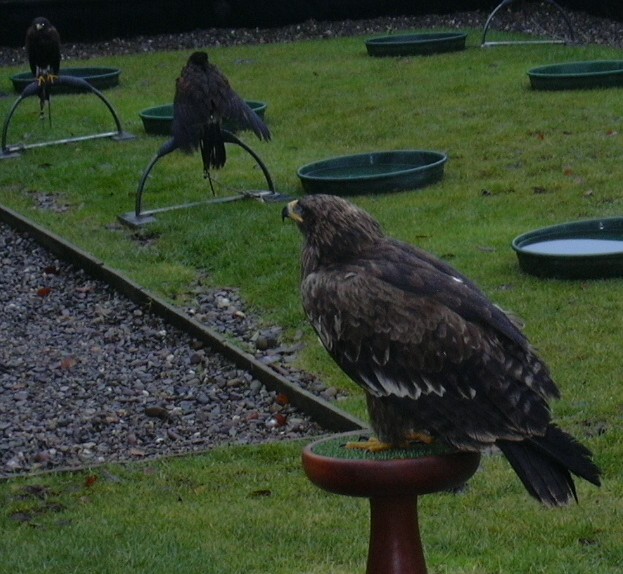
Here is a paragrin falcon. He doesn't want to talk to anyone. He's been up late.

Isn't he a beautiful bird?

I can't remember what type of bird this way, but I think it was another type of Paragrin.
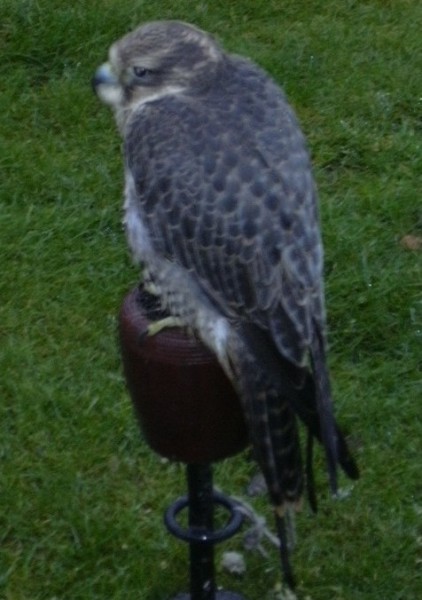
We had a flying demonstration with the paragrins. They are an intersting bird. They are one of the fastest falcons, however, they have really brittle bones and they are quite nervous as well - that is why you will see them with their hoods on.
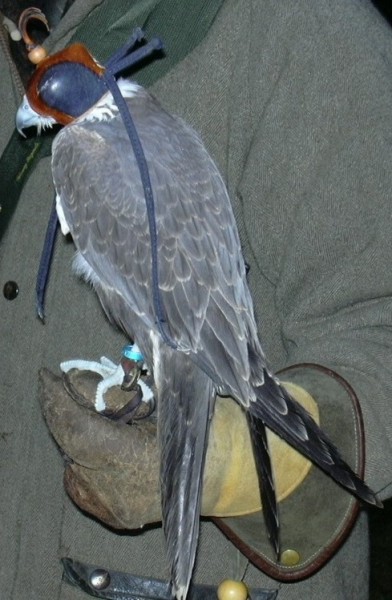
The paragrin falcon is all kit'd and ready to go.

When Harry Potter was released, one of the most popular and sought after pets was, of course, the owl. The owl's eyes actually take 1/3 of the owl's head. They can't move their eyes, but they can spin their head totally around. Above his eyes are horns, which look like ears, however the owl's ears are actually under it's eyes. The other myth is that owls are wise and smart. In actual fact, they aren't. Owls feathers are made up differently than other birds, allowing them to fly without making a sound.

Look at the big fuzzy feet that the owl has. One benefit to having such fuzzy feet is if they jump on a rat or something, if it gets bitten on the feet, the feathers will protect him. Also, look at the character behind him. I'm not exactly sure what he's looking at. Talk about a big cheeky grin.

Any guess on what the next bird that we were flying?

If you guessed a pidgeon, then you'd be wrong.
This is of course, a bald eagle. He is fairly young. You can tell, because he still has quite a bit of grey in his head. This will allow him to fly thru other eagles territories, allowing him to fish and hunt whereever he wishes. When he becomes an adult, his feathers will all turn white and he will then have to fight for his territory.

One thing you quickly notice is how much heavier the eagle is than the Harris Hawks. The animal wrangler actually helps you hold up the eagle when he first lands. The glove that we were wearing with the eagle actually goes over the glove that we were wearing with Harris Hawks and it is three times thicker than a normal glove. Even with all that leather, if the eagle wanted, it could break your arm. So, make sure that you have lots of eagle kibble in your glove so that it doesn't get upset. And, don't try and pet it.
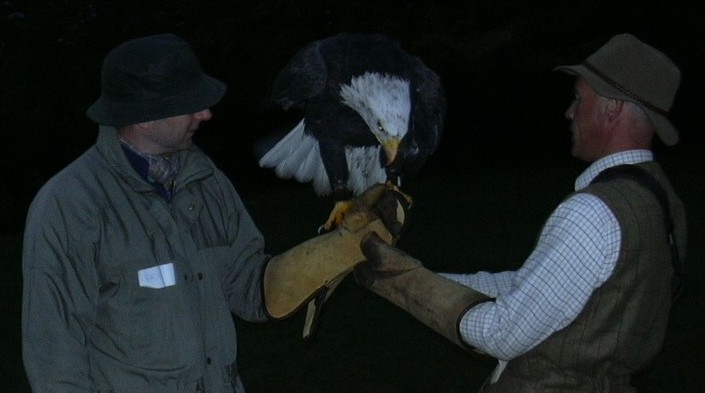
Humm... what do you have in your hand, little man????

And, to finish off this set, we have Kim displaying her bird handling skills, and what a pose the eagle decided to give. Have a good night, and don't try this at home with your local eagle. Good night.
